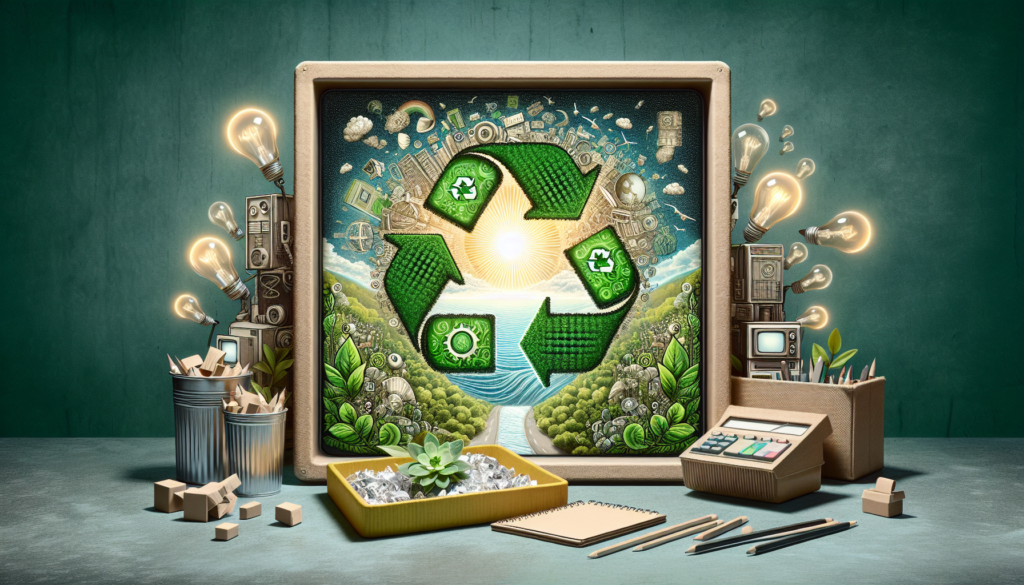In the ever-evolving world of consumerism, one topic has been gaining momentum and capturing the attention of conscientious individuals like yourself – sustainable packaging. As our society becomes increasingly aware of the impact of our choices on the environment, the future of packaging is being reimagined to meet the demands of a greener world. From innovative designs to eco-friendly materials, join us on a journey to explore the promising horizon of sustainable packaging and witness how it’s reshaping the way we consume and protect the planet.
The Importance of Sustainable Packaging
Sustainable packaging plays a crucial role in reducing our environmental impact and preserving our planet for future generations. By adopting sustainable packaging practices, we can minimize waste, preserve resources, and create a safer and healthier world for all. It is essential that we recognize the importance of sustainable packaging and take actionable steps to implement it in our daily lives.
Reducing Environmental Impact
One of the primary reasons why sustainable packaging is so crucial is its ability to reduce environmental impact. Traditional packaging materials, such as plastics, can take hundreds of years to decompose in landfills and contribute to pollution in our oceans and air. By opting for sustainable packaging solutions, we can significantly reduce the amount of waste that ends up in landfills, minimizing our impact on the environment.
Minimizing Waste
Sustainable packaging focuses on minimizing waste throughout the entire lifecycle of a product, from production to disposal. This includes using materials that are easily recyclable or compostable, promoting the use of refillable or reusable packaging, and implementing innovative designs that eliminate unnecessary packaging. By minimizing waste, we can conserve resources, reduce pollution, and create a more sustainable future.
Preserving Resources
Sustainable packaging also plays a vital role in preserving our precious natural resources. By using eco-friendly materials and adopting efficient manufacturing processes, we can reduce the amount of energy, water, and raw materials required to produce packaging. This not only helps to conserve resources but also reduces the carbon emissions associated with manufacturing, contributing to the fight against climate change.
Technological Advances in Sustainable Packaging
Technological advances have paved the way for exciting innovations in sustainable packaging. These advancements offer promising solutions to some of the most pressing environmental challenges we face today, such as plastic pollution and resource depletion.
Biodegradable Materials
One of the most significant technological advancements in sustainable packaging is the development of biodegradable materials. Biodegradable materials, such as plant-based plastics and compostable materials, break down naturally in the environment without leaving harmful residues. These materials offer a sustainable alternative to traditional plastics and help reduce the amount of waste that ends up in landfills or litters our natural landscapes.
Edible Packaging
Edible packaging is another remarkable innovation that holds tremendous potential for sustainable packaging. Edible films and coatings made from food-grade materials can be used to wrap various food products, eliminating the need for additional packaging materials. Not only does this reduce waste, but it also provides an edible and safe option for packaging, reducing the environmental impact associated with traditional packaging materials.
Smart Packaging
Advances in technology have also led to the development of smart packaging solutions. Smart packaging incorporates sensors, indicators, and tracking systems to monitor the quality, safety, and freshness of products. By leveraging technology, smart packaging can help reduce food waste by alerting consumers when a product is about to expire or when proper storage conditions are not being met. This not only minimizes waste but also improves consumer confidence in the products they buy.

Collaboration for a Sustainable Future
Achieving a sustainable future requires collaboration between various stakeholders, including governments, industries, and consumers. By working together, we can implement effective strategies and policies that promote sustainable packaging practices.
Government Initiatives
Governments play a pivotal role in driving the adoption of sustainable packaging practices. Through legislation, regulations, and incentives, governments can encourage businesses to prioritize sustainability and invest in sustainable packaging solutions. By implementing policies that promote the use of eco-friendly materials, support recycling infrastructure development, and set targets for waste reduction, governments can create an enabling environment for sustainable packaging to thrive.
Industry Partnerships
Industry partnerships are another critical component of achieving a sustainable future. By collaborating with suppliers, manufacturers, retailers, and other stakeholders, companies can work together to develop and implement sustainable packaging solutions. These partnerships can lead to shared research and development efforts, knowledge exchange, and the creation of industry-wide standards for sustainable packaging. By pooling resources, expertise, and innovation, industry partnerships can accelerate the adoption of sustainable packaging practices.
Consumer Education
Consumer education and awareness are essential in driving the demand for sustainable packaging. By educating consumers about the benefits of sustainable packaging and providing information on how to choose and dispose of packaging responsibly, we can empower individuals to make more sustainable choices. This can be done through public awareness campaigns, labeling initiatives, and educational programs that highlight the environmental impact of different packaging options. When consumers are well-informed, they can make conscious choices that support sustainable packaging and drive market demand.
Innovative Designs for Sustainable Packaging
In addition to technological advances, innovative packaging designs are key to achieving sustainability goals. By rethinking the way we package products and adopting designs that minimize waste and promote reuse, we can significantly reduce our environmental footprint.
Minimalist Packaging
Minimalist packaging focuses on reducing the amount of unnecessary packaging material used while still ensuring the safety and integrity of the product. By eliminating excess packaging, such as excess layers, inserts, or non-recyclable materials, minimalist packaging minimizes waste and reduces the carbon footprint associated with production and transportation.
Eco-Friendly Materials
Choosing eco-friendly materials is another critical aspect of sustainable packaging design. Materials such as recycled paper, cardboard, or bio-based plastics have a lower environmental impact compared to traditional packaging materials. These materials are renewable, recyclable, and biodegradable, making them a more sustainable choice for packaging applications.
Multi-purpose Packaging
Multi-purpose packaging designs serve multiple functions beyond simply protecting the product. For example, packaging that transforms into a reusable storage container or can be repurposed into another useful item encourages consumers to reuse the packaging instead of disposing of it. By extending the life cycle of packaging, multi-purpose designs reduce waste and promote sustainability.

The Role of Recycling in Sustainable Packaging
Recycling plays a crucial role in the sustainable packaging ecosystem. By diverting waste from landfills and giving materials a second life, recycling helps conserve resources and reduce the environmental impact of packaging.
Closed-loop Systems
Closed-loop recycling systems are designed to recover and recycle post-consumer packaging waste back into new packaging materials. In these systems, materials such as plastics, glass, and paper are collected, sorted, and processed to create new packaging materials. Closed-loop systems ensure that packaging materials are kept in circulation and minimize reliance on virgin resources, making them a sustainable solution.
Recycling Infrastructure
Investments in recycling infrastructure are essential to support the recycling of packaging materials. By improving collection systems, increasing recycling facility capacities, and investing in advanced sorting technologies, we can enhance the efficiency and effectiveness of recycling processes. A robust recycling infrastructure ensures that packaging materials can be recycled properly, reducing the amount of waste that ends up in landfills or incinerators.
Improved Sorting Technologies
Advancements in sorting technologies have made it easier to separate and recover recyclable materials from mixed waste streams. Optical sorting systems, advanced material identification technologies, and automated sorting equipment enable more accurate and efficient sorting of packaging materials. These technologies play a crucial role in enhancing recycling rates and ensuring that packaging waste is properly processed and recycled.
Challenges in Implementing Sustainable Packaging
While sustainable packaging offers numerous benefits, there are also several challenges that must be overcome to fully realize its potential.
Cost Considerations
One of the primary challenges is the perceived higher cost of sustainable packaging compared to traditional packaging. Eco-friendly materials and innovative designs may have higher upfront costs, which can deter some businesses from adopting sustainable packaging practices. However, it is essential to consider the long-term benefits and cost savings associated with sustainable packaging, such as reduced waste disposal fees, improved brand reputation, and increased customer loyalty.
Regulatory Barriers
Regulatory barriers can also pose challenges to implementing sustainable packaging practices. Different regions may have varying regulations and standards regarding packaging materials, recycling requirements, and waste management systems. Harmonizing regulations and removing barriers to sustainable packaging can promote innovation and create a level playing field for businesses. Governments, policymakers, and industry stakeholders need to work together to address these challenges and create an enabling environment for sustainable packaging.
Consumer Behavior
Changing consumer behavior and preferences is another significant challenge in implementing sustainable packaging practices. While there is a growing demand for sustainable products, many consumers still prioritize convenience and affordability over environmental considerations. Educating consumers about the environmental impact of packaging and promoting the benefits of sustainable alternatives can help drive consumer behavior change. Additionally, offering incentives or rewards for choosing sustainable packaging options can encourage consumers to make more sustainable choices.
The Benefits of Sustainable Packaging
Despite the challenges, sustainable packaging offers a wide range of benefits for businesses, consumers, and the environment.
Brand Reputation
Adopting sustainable packaging practices can significantly enhance a company’s brand reputation. As consumers become more environmentally conscious, they are actively seeking out brands that align with their values and prioritize sustainability. By using sustainable packaging, businesses can demonstrate their commitment to environmental stewardship, differentiate themselves from competitors, and build a positive brand image.
Improved Consumer Perception
Consumers today expect businesses to take responsibility for their environmental impact. By using sustainable packaging, companies can meet consumer expectations and improve consumer perception. Sustainable packaging provides reassurance to consumers that the products they purchase are environmentally friendly and promotes a sense of trust and loyalty towards the brand.
Long-term Cost Savings
While sustainable packaging may have some initial cost implications, it can lead to significant long-term cost savings. By reducing packaging waste, companies can minimize disposal fees and associated costs. Additionally, implementing innovative packaging designs that require fewer materials can lead to more efficient production and shipping, further reducing costs. The long-term financial benefits, combined with the environmental advantages, make sustainable packaging a worthwhile investment for businesses.
Industry Trends and Market Opportunities
The shift towards sustainable packaging has created a host of market opportunities and industry trends. As consumer demand for sustainable products continues to grow, businesses that embrace sustainable packaging practices can tap into new markets and strengthen their competitive advantage.
Demand for Sustainable Alternatives
Consumers are increasingly seeking out sustainable alternatives to traditional products, including packaging. Businesses that provide sustainable packaging options can respond to this demand and cater to a growing market segment. By aligning with consumer preferences and offering eco-friendly packaging choices, companies can attract environmentally conscious customers and gain a competitive edge.
Investment in Green Packaging Startups
The interest and investment in green packaging startups and innovative technologies have been on the rise. Venture capital firms, industry leaders, and even governments are recognizing the potential of sustainable packaging and supporting startups that are developing groundbreaking solutions. This investment inflow not only drives innovation in the packaging industry but also presents lucrative opportunities for entrepreneurs and businesses looking to enter the sustainable packaging market.
Circular Economy Approaches
The concept of the circular economy, which aims to eliminate waste and promote the continual use of resources, has gained significant traction in recent years. Sustainable packaging plays a crucial role in achieving a circular economy by designing packaging systems that prioritize reuse, recycling, and recovery. Businesses that embrace circular economy approaches to packaging can benefit from improved resource efficiency, reduced waste, and enhanced environmental performance.
Case Studies: Successful Sustainable Packaging Strategies
Several companies have successfully implemented sustainable packaging strategies, demonstrating the feasibility and benefits of adopting eco-friendly practices.
Patagonia’s Reusable Packaging
Outdoor apparel company Patagonia has made significant strides in sustainable packaging by introducing a reusable packaging program. Customers can opt for the company’s RePack packaging, which is designed to be returned, refilled, and reused. This initiative significantly reduces packaging waste and aligns with the company’s commitment to sustainability.
Seventh Generation’s Sustainable Product Packaging
Seventh Generation, a leading household and personal care products company, has made sustainability a cornerstone of its brand. The company prioritizes the use of recycled and recyclable materials for its product packaging, reducing the environmental impact of its products. By adopting sustainable packaging solutions, Seventh Generation has established itself as a leader in the green packaging space.
Loop’s Zero-Waste Packaging Platform
Loop, a global circular packaging platform, has revolutionized the way products are packaged and delivered. Through partnerships with major brands, Loop offers consumers an innovative system where products are delivered in durable, reusable packaging. Once the products are consumed, the packaging is picked up, cleaned, and reused, creating a zero-waste packaging solution.
The Future Outlook for Sustainable Packaging
The future of sustainable packaging looks promising, with continued technological innovations, global adoption, and robust regulatory frameworks driving the transition.
Technological Innovations
Advancements in technology will continue to drive sustainable packaging innovations. From the development of new bio-based materials to the evolution of smart packaging systems, emerging technologies will enable the creation of more sustainable packaging solutions. The integration of digital technologies, such as blockchain, can also enhance transparency and traceability in packaging supply chains, further supporting sustainable practices.
Global Adoption
The adoption of sustainable packaging practices is gaining momentum worldwide. Governments, businesses, and consumers are recognizing the urgency of addressing environmental challenges and are actively seeking sustainable alternatives. As sustainability becomes a global priority, the demand for sustainable packaging will continue to grow, driving adoption and innovation at a global scale.
Regulatory Frameworks
Governments around the world are increasingly implementing regulations and frameworks to promote sustainable packaging practices. From plastic bans to extended producer responsibility programs, these regulatory initiatives create an impetus for businesses to adopt sustainable packaging solutions. Strengthening and harmonizing these regulatory frameworks will be crucial in driving widespread adoption and standardizing sustainable packaging practices globally.
In conclusion, sustainable packaging is more important than ever in our pursuit of a greener and more sustainable future. By reducing environmental impact, minimizing waste, preserving resources, and embracing technological advances, we can create a more sustainable and resilient packaging ecosystem. Collaboration among governments, industries, and consumers is essential to accelerate the transition towards sustainable packaging. By addressing challenges, capitalizing on the benefits, and seizing market opportunities, we can build a future where sustainable packaging becomes the norm. The future of sustainable packaging is within our reach, and it is up to us to ensure that it becomes a reality.

